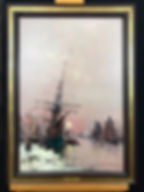
Eugène GALIEN-LALOUE (1854-1951)
- Soleil d'Hiver sur la Seine -
Click Pictures to Enlarge






SOLD
Eugène GALIEN-LALOUE (1854-1941)
Oil on canvas in excellent condition signed lower right
Dimensions unframed: H 24.8 in. x W 17.5 in. ; H 63.0 cm x W 44.5 cm
Dimensions framed: H 29.5 in. x W 22.1 in. ; H 74.9 cm x W 56.1 cm
Our opinion
This painting is of museum quality and one of the most beautiful marine paintings we have come across from Eugene Galien-Laloue. The colours are just magnificent: the mauve of the sky, the green oxidised copper hull, and the white snow. This combination gives an incredible atmosphere and poetry to this painting. It is one of our favourites.
About the Artist
Eugene Galien-Laloue was born in Montmartre in 1854. His father was a painter and decorator for theatres in Paris who died when he was sixteen. Eugene did his military duty during the Prussian War and by the end in 1871 had decided to become a painter. In 1874 he was recruited by the French Railway Society as an illustrator to depict the new provincial destinations covered by the fast-expanding French railway network. This gave Eugene the opportunity to travel across France where he painted multiple rural countryside landscapes.
Eugene was the pupil of Leon Germain Pelouse (1838-1891) from the Barbizon school. He exhibited for the first time in 1876 at the Museum of Reims with the painting Le quai aux fleurs par la neige (Flower Market Along the Seine Under the Snow). The following year he exhibited for the first time at the annual Parisian Salon with another painting: En Normandie (In Normandy). Thereafter, he became a regular of Parisian exhibitions and salons.
His most well-known works are detailed gouaches representing Parisian street scenes. His paintings of the early 1900s depict a happy bustling Paris of “La belle epoque” with horse drawn carriages, and well-dressed Parisians walking along the grand boulevards. Eugene enjoyed depicting Paris in fall or winter, with reflections of scenes in rainy pavements or covered with snow. His use of light is remarkable, whether it depicts a sunrise, sunset, or to contrast an overcast sky with city lights.
Galien-Laloue’s street scenes became extremely popular, but due to an exclusivity contract with a major Parisian Gallery, Eugene started to use pseudonyms to paint more personal artworks. His known aliases included E. Galiany, L. Dupuis and J. Lievin, which he used for this painting – the name of a soldier he had met during the Franco-Prussian war. He travelled out of Paris often to depict the landscapes he cherished in Normandy documenting life along the banks of the river Seine with an interest and talent for marine paintings.
As World War I broke out, he was exempt from military service because of his age at the time and he instead chose to depict the battlefields on canvas. Galien-Laloue continued to paint until 1940, when he broke the arm with which he held his brush. He died in 1941 in his daughter’s house where he had taken refuge at the beginning of the Second World War.
Galien-Laloue's works are valued not only for their contribution to art, but also for their historical insights into early 20th century life in France. His works are highly collectible and can be found in numerous Art Museums in France and in the United States.
